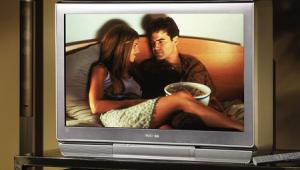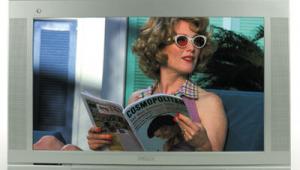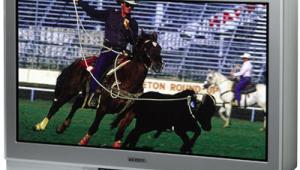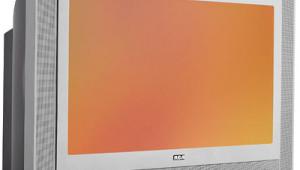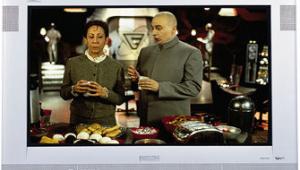Philips 34PW9818 16:9 HD-ready direct-view monitor Page 2
 Despite what's been claimed in some writeups of the 34PW9818, none of the superb picture quality from HDTV and progressive-scan DVD had to do with PixelPlus, which is not applied to either of the set's high-bandwidth inputs. Given how inexpensive high-quality progressive-scan DVD players have become, I didn't bother auditioning the set's built-in progressive-scan feature, Natural Motion, with an interlaced DVD player, nor was I concerned about what PixelPlus might do to such a signal—I'm sure that SGHT readers considering buying a 34PW9818 will be using a progressive-scan DVD player with it. More important was what PixelPlus and Natural Motion did for satellite, cable, and broadcast quality. That was, in a word, miraculous.
Despite what's been claimed in some writeups of the 34PW9818, none of the superb picture quality from HDTV and progressive-scan DVD had to do with PixelPlus, which is not applied to either of the set's high-bandwidth inputs. Given how inexpensive high-quality progressive-scan DVD players have become, I didn't bother auditioning the set's built-in progressive-scan feature, Natural Motion, with an interlaced DVD player, nor was I concerned about what PixelPlus might do to such a signal—I'm sure that SGHT readers considering buying a 34PW9818 will be using a progressive-scan DVD player with it. More important was what PixelPlus and Natural Motion did for satellite, cable, and broadcast quality. That was, in a word, miraculous.
I don't understand why so many reviewers have downplayed the significance of PixelPlus. One newspaper reporter referred to it as a "detail enhancer," making it seem like a sharpness control on steroids. It's much more than that. It makes blurry, compressed satellite images look "HD-like." I compared PixelPlus–processed CBS feeds from DirecTV, stretched with the set's aspect-ratio control, to CBS's over-the-air HD signal. Of course, the true HD picture looked richer and more filmlike, but the processed version was remarkably close.
Seen from normal viewing distances, PixelPlus processing is a big plus with no negatives—especially compared to processing I've seen from some other companies. With both video and film material, the picture was sharper, clearer, and more detailed, without looking artificial or "processed." If there were motion artifacts, I didn't notice them; if they were there, they were too difficult to see without using a magnifying glass (I didn't) or pressing my nose to the screen. Philips plans to include PixelPlus in new, larger sets. That will make interesting viewing, and it will be a more significant test of the circuitry.
Conclusions
The 34PW9818's lack of DVI connectivity is a frustrating omission, unless you're just looking for a great 34-inch direct-view TV on which to watch DVDs. In that case, I don't think you can beat this handsome-looking set's performance and features. But if HDTV is part of your picture, your willingness to gamble on the eventual downrezzing of analog component-video HD material will determine this set's attractiveness for you.
That issue aside, the non–PixelPlus 34PW9817 I reviewed in October 2001 had a list price of $3999. The 34PW9818, at $2800 (around $2500 on the street), outperformed the older model in every way, and the inclusion of PixelPlus means that viewers of standard cable and satellite signals now have a way to enjoy an HD-like picture from regular TV channels. Also, true HDTV looks fantastic, even though you won't get the full 1920x1080i, "window on the event" resolution possible from HD—but no 34-inch set I've yet seen can deliver that.
Given how far the prices of CRT-based rear-projection TVs have fallen, the only reason for buying a $2800, 34-inch, direct-view set is if you have a space problem. And given how much more expensive similarly sized high-resolution plasma displays are (as opposed to some of the junk displays being sold cheaply today), CRT sets are still the best way to go. This high-performance, feature-filled set from Philips is a great way to do it.
